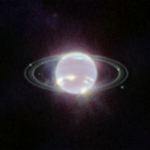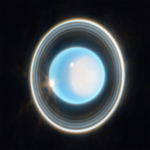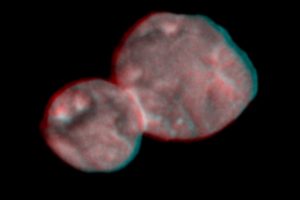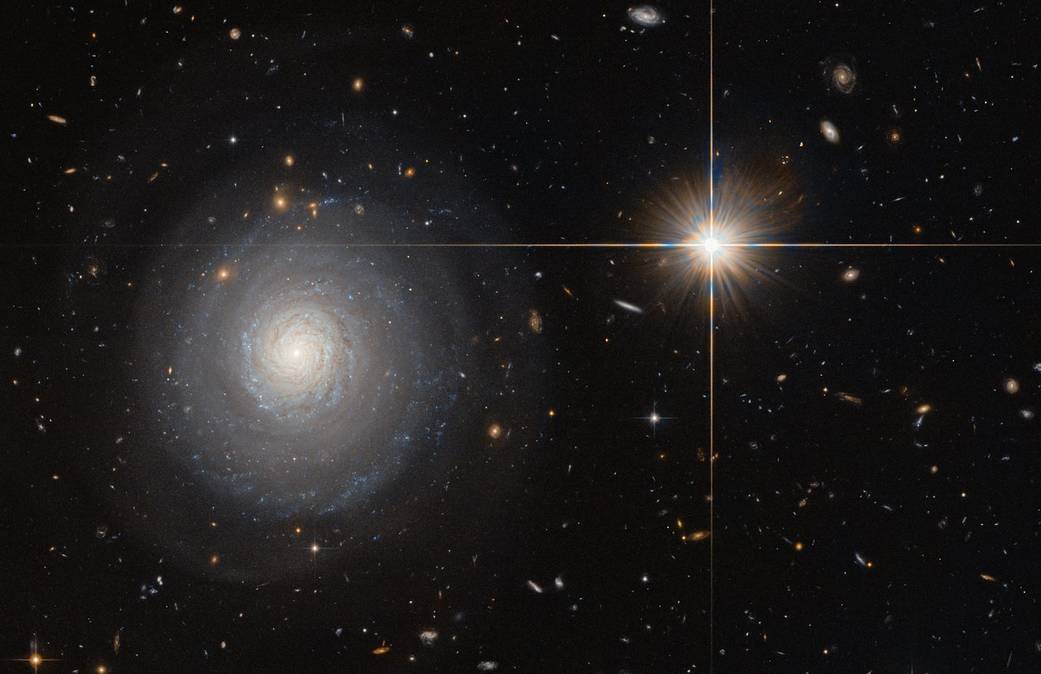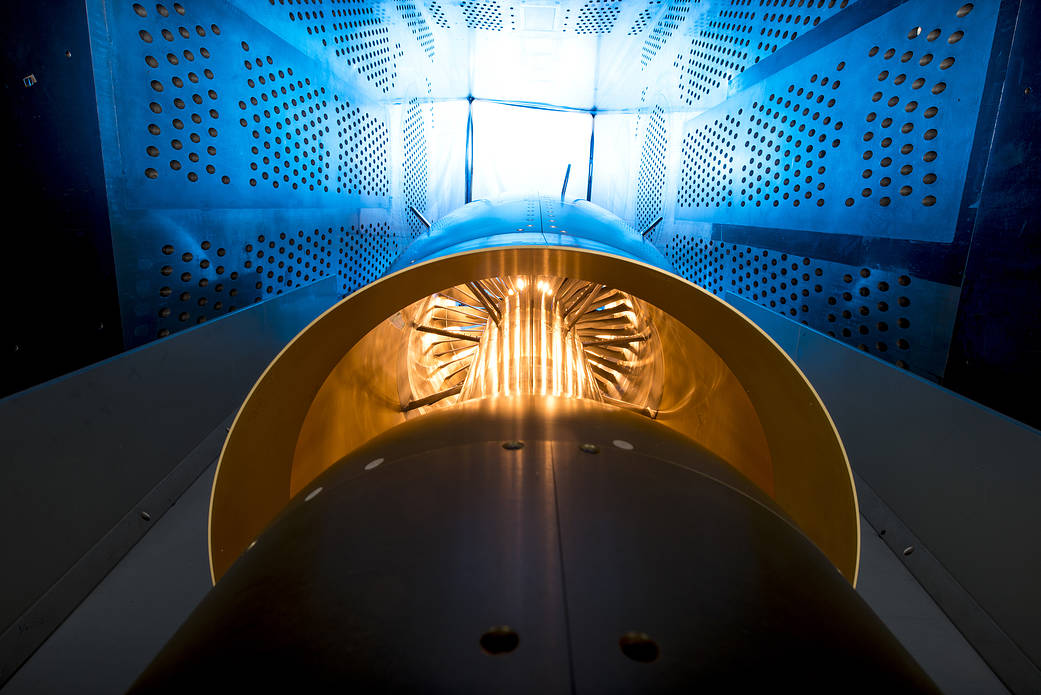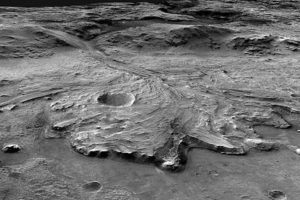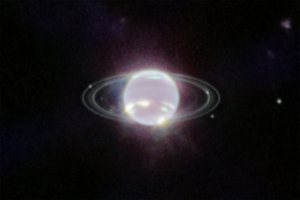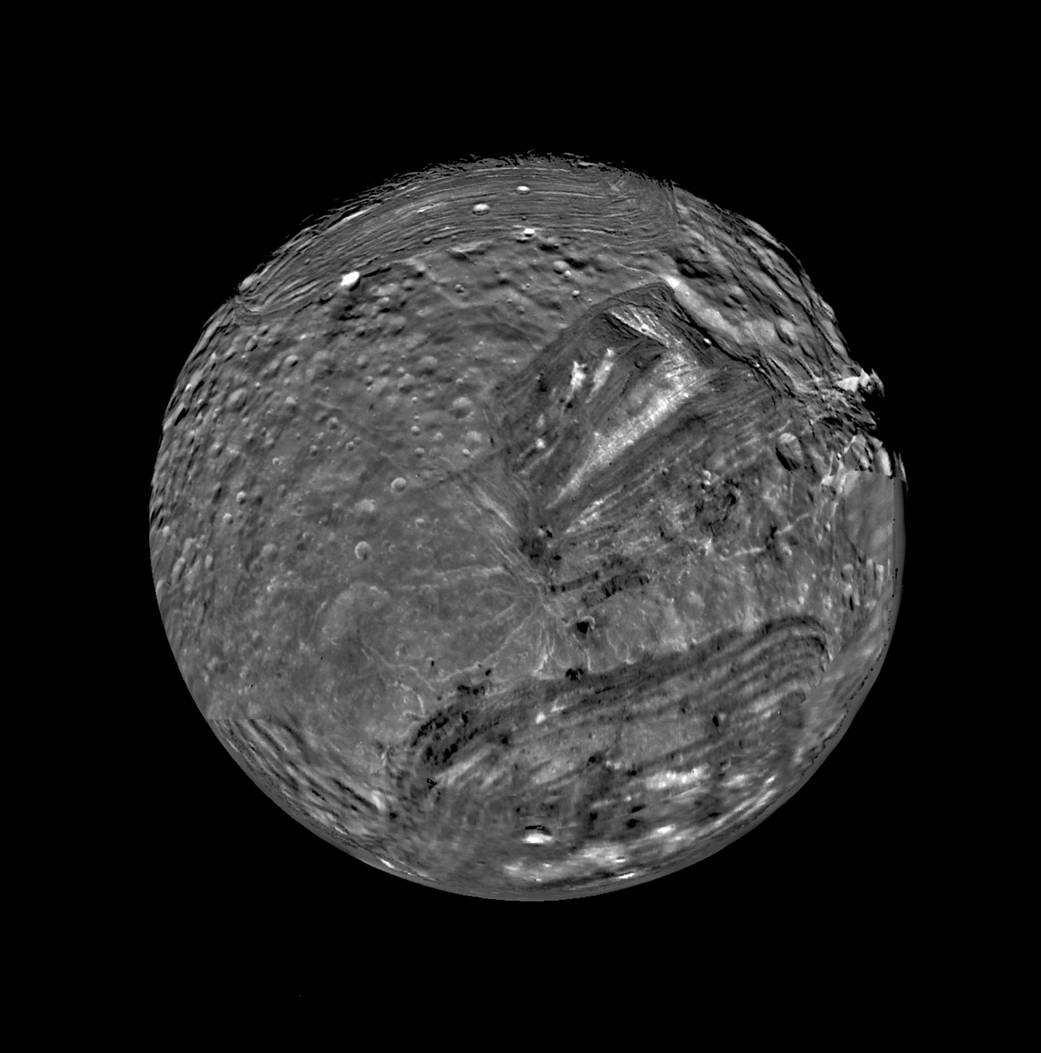This zoomed-in image of Uranus, captured by Webb’s Near-Infrared Camera (NIRCam) Feb. 6, 2023, reveals stunning views of the planet’s rings. The planet displays a blue hue in this representative-color image, made by combining data from two filters (F140M, F300M) at 1.4 and 3.0 microns, which are shown here as blue and orange, respectively
Credits: NASA, ESA, CSA, STScI. Image processing: J. DePasquale (STScI)
2023年2月6日にジェームズ・ウェッブ宇宙望遠鏡搭載の近赤外線カメラ (NIRCam) によって撮影された天王星の画像は、天王星の輪をはっきりと見ることができます。 この画像は、1.4 ミクロンと 3.0 ミクロンの 2 つのフィルター (F140M、F300M) のデータから合成したカラー画像です。夫々が青色とオレンジ色に対応しています。
NASA’s Webb Scores Another Ringed World With New Image of Uranus
NASA’s Webb Scores Another Ringed World With New Image of Uranus | NASA
Following in the footsteps of the Neptune image released in 2022, NASA’s James Webb Space Telescope has taken a stunning image of the solar system’s other ice giant, the planet Uranus. The new image features dramatic rings as well as bright features in the planet’s atmosphere. The Webb data demonstrates the observatory’s unprecedented sensitivity for the faintest dusty rings, which have only ever been imaged by two other facilities: the Voyager 2 spacecraft as it flew past the planet in 1986, and the Keck Observatory with advanced adaptive optics.
NASA のジェームズ ウェッブ宇宙望遠鏡は太陽系の氷の巨大惑星である天王星の驚くべき画像を、2022年に公開した画像に続きいて撮影しました。 新しい画像は、天王星の環と大気の明るい特徴を捉えています。ウェッブのデータは、1986年に天王星に最接近した探査機ボイジャー 2号と、高度な光学補正機能を備えたケック天文台によってしか画像化されていない、非常に観測困難な塵でできた環を前例のない感度で撮影しています。
The seventh planet from the Sun, Uranus is unique: It rotates on its side, at roughly a 90-degree angle from the plane of its orbit. This causes extreme seasons since the planet’s poles experience many years of constant sunlight followed by an equal number of years of complete darkness. (Uranus takes 84 years to orbit the Sun.) Currently, it is late spring for the northern pole, which is visible here; Uranus’ northern summer will be in 2028. In contrast, when Voyager 2 visited Uranus it was summer at the south pole. The south pole is now on the ‘dark side’ of the planet, out of view and facing the darkness of space.
太陽から 7 番目の惑星である天王星はユニークです。公転面から約 90 度の角度で横向きに回転します。 これにより天王星の両極が何年にもわたり絶え間なく日光を受け、その後同期間の完全な暗闇が続くため、極端な季節間隔になります。 (天王星が太陽を周回するのに 84 年かかります) 現在、ここに見える北極は晩春です。 天王星の北半球の夏は 2028 年になります。これとは対照的にボイジャー 2 号が天王星に最接近した時の南極は夏でした。 南極は現在「暗黒面」にあり、視界から外れ、宇宙空間の闇に面しています。
This infrared image from Webb’s Near-Infrared Camera (NIRCam) combines data from two filters at 1.4 and 3.0 microns, which are shown here in blue and orange, respectively. The planet displays a blue hue in the resulting representative-color image.
ウェッブ宇宙望遠鏡の近赤外線カメラ (NIRCam) による赤外線画像は、1.4 ミクロンと 3.0 ミクロンの 2 つのフィルターからのデータを合成したもので、それぞれ青とオレンジで示されています。 天王星の画像は青色の色合いになっています。
When Voyager 2 looked at Uranus, its camera showed an almost featureless blue-green ball in visible wavelengths. With the infrared wavelengths and extra sensitivity of Webb we see more detail, showing how dynamic the atmosphere of Uranus really is.
ボイジャー 2 号が天王星に最接近した当時は、撮影カメラは可視波長のみであったため、ほとんど特徴のない青緑色の球体に見えました。 ウェッブの赤外線波長で高感度なカメラにより、天王星の大気が実際にどれほど動的であるか、より詳細に見ることができます。
On the right side of the planet there’s an area of brightening at the pole facing the Sun, known as a polar cap. This polar cap is unique to Uranus – it seems to appear when the pole enters direct sunlight in the summer and vanish in the fall; these Webb data will help scientists understand the currently mysterious mechanism. Webb revealed a surprising aspect of the polar cap: a subtle enhanced brightening at the center of the cap. The sensitivity and longer wavelengths of Webb’s NIRCam may be why we can see this enhanced Uranus polar feature when it has not been seen as clearly with other powerful telescopes like the Hubble Space Telescope and Keck Observatory.
天王星の右側に極冠として知られる、太陽に面することで明るく見える領域があります。この極冠は天王星独自のもので-極が夏に直射日光に当たると現れ、秋に消えるように見えます。 これらのウェッブで撮影されたデータは科学者が現在謎に包まれているメカニズムを理解するのに役立ちます。ウェッブは極冠の驚くべき面を明らかにしたのです:それは極冠の中心でわずかに他より強く光る領域です。 ウェッブの NIRCam の感度とより長い波長が、ハッブル宇宙望遠鏡やケック天文台のような他の強力な望遠鏡でははっきりと見えなかった極冠の特徴を見ることができる理由かもしれません。

This wider view of the Uranian system with Webb’s NIRCam instrument features the planet Uranus as well as six of its 27 known moons (most of which are too small and faint to be seen in this short exposure). A handful of background objects, including many galaxies, are also seen.
Credits: NASA, ESA, CSA, STScI. Image processing: J. DePasquale (STScI)
ウェッブの NIRCam で撮影した天王星系の広い視野には、天王星とその 27 個の既知の衛星のうちの 6 個が含まれています (他の衛星は小さすぎ、この短時間の露出では見えません)。 多くの銀河を含む少数の背景天体も見られます。
At the edge of the polar cap lies a bright cloud as well as a few fainter extended features just beyond the cap’s edge, and a second very bright cloud is seen at the planet’s left limb. Such clouds are typical for Uranus in infrared wavelengths, and likely are connected to storm activity.
This planet is characterized as an ice giant due to the chemical make-up of its interior. Most of its mass is thought to be a hot, dense fluid of “icy” materials – water, methane, and ammonia – above a small rocky core.
Uranus has 13 known rings and 11 of them are visible in this Webb image. Some of these rings are so bright with Webb that when they are close together, they appear to merge into a larger ring. Nine are classed as the main rings of the planet, and two are the fainter dusty rings (such as the diffuse zeta ring closest to the planet) that weren’t discovered until the 1986 flyby by Voyager 2. Scientists expect that future Webb images of Uranus will reveal the two faint outer rings that were discovered with Hubble during the 2007 ring-plane crossing.
Webb also captured many of Uranus’ 27 known moons (most of which are too small and faint to be seen here); the six brightest are identified in the wide-view image. This was only a short, 12-minute exposure image of Uranus with just two filters. It is just the tip of the iceberg of what Webb can do when observing this mysterious planet. In 2022, the National Academies of Sciences, Engineering, and Medicine identified Uranus science as a priority in its 2023-2033 Planetary Science and Astrobiology decadal survey. Additional studies of Uranus are happening now, and more are planned in Webb’s first year of science operations.
The James Webb Space Telescope is the world’s premier space science observatory. Webb will solve mysteries in our solar system, look beyond to distant worlds around other stars, and probe the mysterious structures and origins of our universe and our place in it. Webb is an international program led by NASA with its partners, ESA (European Space Agency) and the Canadian Space Agency.
Media Contacts:
Laura Betz
NASA’s Goddard Space Flight Center, Greenbelt, Md.
laura.e.betz@nasa.gov
Christine Pulliam
Space Telescope Science Institute, Baltimore, Md.
cpulliam@stsci.edu
Last Updated: Apr 7, 2023
Editor: Jamie Adkins

